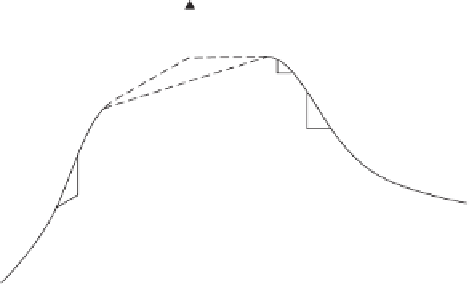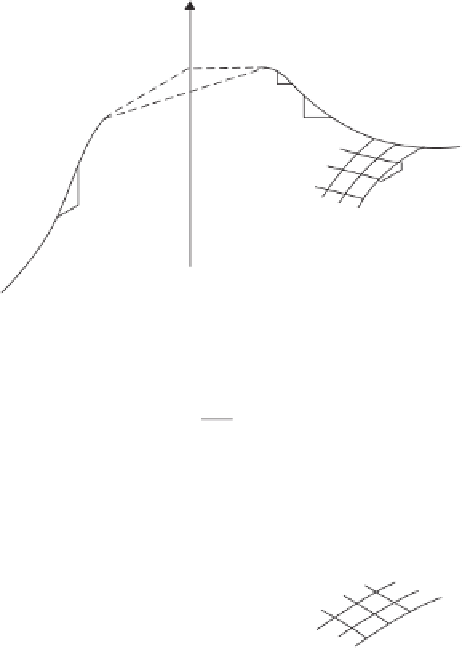Environmental Engineering Reference
In-Depth Information
approaches zero, a change in matric suction is no longer
effective in producing a change in overall volume of the
soil. Any volume change which takes place when the soil is
in a dry condition (e.g., below residual conditions) will be
mainly due to a change in the net normal stress. However,
a net normal stress increase applied to a dry soil is unlikely
to cause a change in the volume of water in the soil (i.e.,
m
1
k
=
Δ
V
v
V
0
Constant void
ratio plane
Saturated condition
(
S
=100%)
m
2
≈
m
v
Dry condition
(
S
= 0)
|
m
2
|<|
m
w
2
|
m
2
= 0
Unsaturated
(
S
< 100%)
m
1
k
m
1k
=
m
v
0). Stated another way, the total soil volume change
in a dry soil is related to a change in the volume of air (i.e.,
m
1
k
=
m
1
k
) in the soil. Only changes in net normal stress
are likely to produce volume changes in a dry soil.
Darcy's law and Fick's law can be used to describe water
flow and air flow, respectively, through an unsaturated soil.
Matric suction (
u
a
-
u
w
)
(a)
16.2.3 Derivation of Consolidation Equations
for Unsaturated Soil
For an isothermal, transient flow analysis, two fluids are
assumed to flow independently from an unsaturated soil,
namely, water and air. Two independent PDEs are required to
solve for the pore-water and pore-air pressures with respect
to time (i.e., two-phase flow approach). The pore-water and
pore-air PDEs must satisfy continuity with respect to the
water and air phases. Rigorous, multidimensional formula-
tions require that the continuity equations be coupled with
the equilibrium equations (Dakshanamurthy et al., 1984).
Uncoupled formulation of the consolidation and swelling
equations can also be derived for solving unsaturated soil
problems. It would appear that the uncoupled consolidation
formulations for unsaturated soils are satisfactory for
engineering practice.
The excess pore-air pressure throughout the soil mass can
often be assumed to be negligible or to be rapidly dissipated.
(Rahardjo, 1990). In these situations, only the water phase
PDE needs to be solved. This is anticipated to be the case,
for example, when predicting the swelling of an unsaturated
soil as a result of wetting of the soil from the ground surface.
There may be other problems where only the excess pore-
air pressure is of significance, and in these cases, only the
pore-air PDE needs to be solved.
The application of total stress to a soil provides the geotech-
nical engineer with insight into the behavior of an unsaturated
soil. After applying a total stress, an immediate settlement
will occur followed by the dissipation of excess pore-water
and pore-air pressures with time. It is necessary to solve
the pore-water and pore-air PDEs in order to predict the
pore-water and pore-air pressures as a function of time. The
initially generated pore-air and pore-water pressures can be
evaluated using pore pressure parameters. The application of
a total stress induces an excess pore-air pressure which is
smaller than the excess pore-water pressure. The magnitude
of generated excess pore pressures depends upon the relative
compressibility of the air-water mixture and the soil structure
compressibility.
A one-dimensional transient flow equation for the water
and air phases can be derived by equating the time derivative
Δ
V
w
V
0
Constant water
content plane
m
2
≈
m
v
Saturated condition
(
S
=100%)
Dry condition
(
S
= 0)
|
m
w
2
|>|
m
2
|
Unsaturated
(
S
< 100%)
m
w
2
≈
0
m
1
k
=
m
v
m
w
1
≈
0
Matric suction (
u
a
-
u
w
)
(b)
Δ
V
a
V
0
Dry condition
(
S
= 0)
Unsaturated
(
S
< 100%)
m
2
≈
0
m
k
=
m
2
−
m
w
2
Saturated condition
(
S
= 100%)
m
1
k
≈
m
1
k
(+)
m
2
= 0
Matric suction (
u
a
-
u
w
)
m
1
a
k
=
0
(c)
Figure 16.1
Typical form for constitutive surfaces for unsatu-
rated soil: (a) soil structure constitutive surface; (b) water phase
constitutive surface; (c) air phase constitutive surface.
stress state changes since a net normal stress produces larger
overall volume change than is produced for the change in
volume of water in the element.
As the soil approaches dry conditions (i.e.,
S
0), the
m
2
and
m
2
coefficients approach zero (Fig. 16.1). Conse-
quently, the
m
2
coefficient also approaches zero (Eq. 16.6).
This means that when the degree of saturation of the soil
=
























Search WWH ::

Custom Search